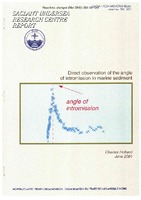| dc.contributor.author | Holland, Charles W. | |
| dc.date.accessioned | 2018-10-11T14:09:07Z | |
| dc.date.available | 2018-10-11T14:09:07Z | |
| dc.date.issued | 2001/06 | |
| dc.identifier | 12882 | |
| dc.identifier.govdoc | SM-381 | |
| dc.identifier.uri | http://hdl.handle.net/20.500.12489/570 | |
| dc.description.abstract | High porosity marine sediments like silty clays have the curious property that the speed of sound through its bulk medium is lower than that of the interstitial pore fluid. When a high porosity sediment is at the water sediment interface, classical theory predicts that there is an angle at which the reflection coefficient is zero, and there is total transmission of sound into the seafloor. This angle is called the angle of intromission and has not been directly observed at the seafloor to the author's knowledge. Data from a new measurement technique show this phenomenon with remarkable clarity. Measurements of the angle of intromission in the coastal region of Italy indicate that the properties of the surficial high porosity sediments are surprisingly constant over large areas. A simple, but robust inversion method is shown for which the sediment sound speed and density can be directly obtained. | |
| dc.format | vi, 12 p. : ill. ; 9 fig. | |
| dc.language | English | |
| dc.publisher | NATO. SACLANTCEN | |
| dc.subject | Seafloor sediments | |
| dc.subject | Geoacoustic inversion | |
| dc.subject | Sound velocity in sea water | |
| dc.subject | Modelling and environmental measurements | |
| dc.title | Direct observation of the angle of intromission in marine sediment | |
| dc.type | Scientific Memorandum (SM) | |
